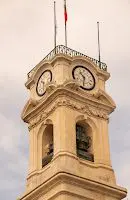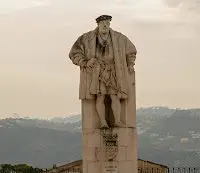Destination Portugal: Coimbra
After spending a couple of days in Porto, we traveled south to historic Coimbra, the fourth-largest city in Portugal.
 |
| Belltower at the university |
Our half-day visit focused on the University of Coimbra and the shopping area near the Mondego River. There’s a limit on what you can see before moving to the next destination on the itinerary.
The Romans found the city, naming it Aeminium in the first century. In the succeeding centuries, the Suebi, Alans, Visigoths, and Muslims ruled for periods of time before King Ferdinand I of Leon reconquered the territory in 1064.
You might say that Coimbra is a college town, as most activity appears to revolve around the campus that sits atop the hill overlooking the venerable city.
 |
| King Joao III statue |
The public university, which has 23,000 students, is a UNESCO World Heritage Site because of its architectural and cultural heritage. Although created in Lisbon in 1290, officials permanently established it in Coimbra in 1537 during the reign of King Joao (John) III, and it’s the oldest continuous higher Education operation in Portugal. A statue of the king stands in the university’s courtyard, the former Alcacova Palace.
 |
| Joanine Library |
Among the places to see at the university is the Joanine Library, which contains many valuable documents and books dating back to the 16th century. Construction started in 1717 and completed in 1728. It’s named in honor of King Joao (John) V. The building is registered as a National Monument.
Here are a few other images from Coimbra:
 |
| The Rainha Santa Isabel bridge crossing the Mondego River |
 |
| The Tricana of Coimbra sculpture, honoring a woman of the city |
 |
| Sculpture celebrating Fado guitar |
 |
| Monument to 19th century Prime Minister Joaquin Antonio de Auigar |
 |
| Coimbra street scene |
 |
| Shopping district |
 |
| Santa Cruz Church and Monastery |
I’ve only touched on a few things to see and do in Coimbra, but it’s definitely a place to spend several days and take in the history and culture of this beautiful city.
My next stop will be in Evora.
Until the next time . . .
Michael Embry is a multi-genre author of 15 books.









